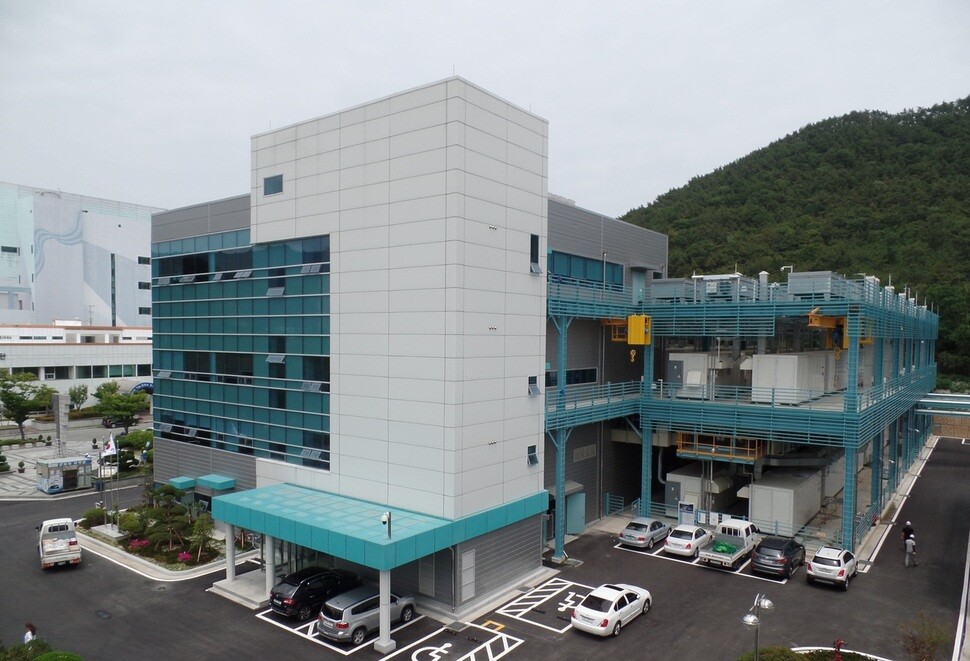hankyoreh
Links to other country sites 다른 나라 사이트 링크
Busan to open new hydrogen fuel cell power plant

As Busan City announces a new plan to generate 100% of the city’s energy from renewable sources by 2050, a new hydrogen fuel cell power plant has begun operation in the city center. The city announced on Aug. 28 that a ceremony to celebrate the completion of the facility would be held inside the Shinsigaji Group Energy Provision Facility in Jwa-dong, Haeundae District the following day, with up to 200 officials including Busan Mayor Seo Byung-soo and Busan Metropolitan Council Chairman Baek Jong-heon in attendance.
The hydrogen fuel cell power plant extracts hydrogen from natural gas and combines it with oxygen collected from the air to produce an electric reaction that generates heat and electricity, serving as an eco-friendly, decentralized power generation facility. This process is highly energy-efficient and does not produce any carbon emissions.
The Shinsigaji area in Haeundae District was built in 1990, and the site where the hydrogen plant is located is home to a large regional heating facility where heat generated from the incineration of waste is combined with gas to create fuel that powers boilers. However, since a facility that could convert domestic waste into fuel opened at the Saenggok landfill in the Gangseo District, the amount of trash being incinerated has halved, leading to the closure of one of the two incinerators in Haeundae.
When this caused heating bills to rise by 21% for local residents, the local government began to seek out an alternative energy source. Busan City eventually decided to construct a hydrogen fuel cell power plant, taking into account the fact that the site was located in the city center. In December 2012, the city offered the project to Korea Hydro & Nuclear Power (KHNP), the public enterprise that operates nuclear power plants in Korea.
In cooperation with KHNP, Busan City Gas Company and Samsung C&T, Busan City created a special purpose entity in April 2014, and a total of 180.8 billion won (about US $165 million) – of which 11.8 billion won (about US $10 million) was from public funds and 169 billion won (about US $153 million) from private capital - was invested to build the facility. Construction got underway in 2015, and the plant began commercial operation upon its completion in June this year.
The hydrogen fuel cell power plant consists of 70 hydrogen fuel cells that each produce 0.44 MW, with a total generation capacity of 30.8 MW. The facility sells 250,000 MWh of electricity per year to KEPCO, which is equivalent to 13.8% of all electricity consumed in the Haeundae District. The plant also produces 240,000 Gcal (gigacalories) of heat annually, which will be used to provide heating to 43,000 households in the Shinsigaji area. Busan City hopes that this will reduce the city’s carbon dioxide emissions by 30,000 tons per year while also cutting heating bills for local residents.
The launch of the new facility is in line with Busan’s energy strategy, with 2017 serving as the first year of its Clean Energy City policy. In January, the city announced that it would refrain from operating any local nuclear power plants, including the Kori-1 nuclear reactor that was permanently decommissioned in June this year and all nine reactors in the Kori and Shin Kori complex which are either currently in operation or awaiting construction. By 2050, Busan plans to become a “clean energy city” that is 100% reliant on renewable sources such as solar energy and wind power.
By Kim Kwang-soo, Busan correspondent
Please direct questions or comments to [english@hani.co.kr]

Editorial・opinion
![[Column] A death blow to Korea’s prosecutor politics [Column] A death blow to Korea’s prosecutor politics](https://flexible.img.hani.co.kr/flexible/normal/500/300/imgdb/original/2024/0415/7517131654952438.jpg) [Column] A death blow to Korea’s prosecutor politics
[Column] A death blow to Korea’s prosecutor politics![[Correspondent’s column] The US and the end of Japanese pacifism [Correspondent’s column] The US and the end of Japanese pacifism](https://flexible.img.hani.co.kr/flexible/normal/500/300/imgdb/original/2024/0412/1017129080945463.jpg) [Correspondent’s column] The US and the end of Japanese pacifism
[Correspondent’s column] The US and the end of Japanese pacifism- [Guest essay] How Korea turned its trainee doctors into monsters
- [Guest essay] As someone who helped forge Seoul-Moscow ties, their status today troubles me
- [Editorial] Koreans sent a loud and clear message to Yoon
- [Column] In Korea’s midterm elections, it’s time for accountability
- [Guest essay] At only 26, I’ve seen 4 wars in my home of Gaza
- [Column] Syngman Rhee’s bloody legacy in Jeju
- [Editorial] Yoon addresses nation, but not problems that plague it
- [Column] Can Yoon and Han stomach humble pie?
Most viewed articles
- 1[News analysis] Watershed augmentation of US-Japan alliance to put Korea’s diplomacy to the test
- 2[Guest essay] How Korea turned its trainee doctors into monsters
- 3[Column] A death blow to Korea’s prosecutor politics
- 4[Photo] Cho Kuk and company march on prosecutors’ office for probe into first lady
- 5[Column] A third war mustn’t be allowed
- 6‘National emergency’: Why Korean voters handed 192 seats to opposition parties
- 7Exchange rate, oil prices, inflation: Can Korea overcome an economic triple whammy?
- 8After Iran’s attack, can the US stop Israel from starting a regional war?
- 9[Editorial] New KBS chief is racing to deliver Yoon a pro-administration network
- 10[Editorial] Stagnant youth employment poses serious issues for Korea’s future